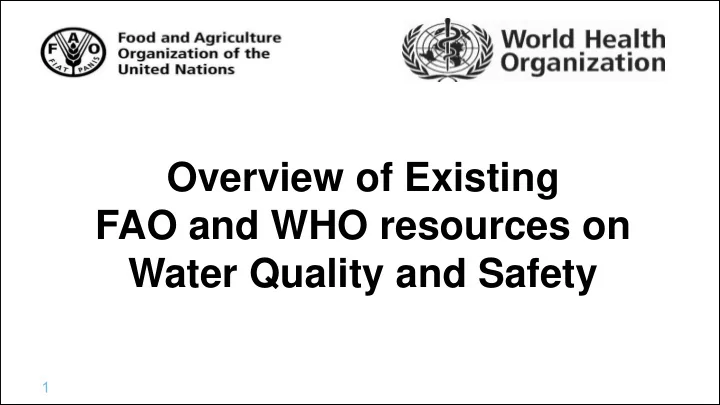

Overview of Existing FAO and WHO resources on Water Quality and Safety 1 |
Protecting Surface Quantitative Microbiological Risk Assessment Water for Health Wastewater Coastal and Fresh waters Water source Guidelines for Drinking- Potable Reuse: water Quality Guidelines for Safe Guidance for Producing Surveillance and Recreational Water Safe Drinking-Water Control of Community Environments Guidelines for the safe Water Supplies use of wastewater, Water Safety Plan excreta and greywater Manual Sanitation Safety Water Safety in Planning Distribution Systems Drinking Water Agriculture, Aquaculture Recreational Use 2 |
3 |
4 |
Health-based targets Public health context (Chapter 3) and health outcomes National Regulatory Body Microbial aspects (Chapters 7 and 11) Water Safety Plans Chemical aspects (Chapter 4) (Chapters 8 and 12) System Management and Monitoring assessment communication Radiological aspects (Chapter 9) Water Utility Acceptability aspects Surveillance (Chapter 10) (Chapter 5) Surveillance Agency Specific Circumstances (Chapter 6) Climate change, Rainwater harvesting, Desalination, Travellers, Emergencies, Buildings, 5 | Health-care facilities etc
Type of Nature of target Typical applications Notes target • Health Defined tolerable Used to inform Guidelines define a Outcome burden of disease derivation of other tolerable burden of disease of 10 -6 DALY • No adverse effect/ targets negligible risk per person per year Water Guideline Values Chemical hazards Based on individual Quality chemical risk assessment Performance Specified removal of Microbial and Set at national level hazards chemical hazards based on risk assessment and Specified Defined technologies Control of microbial health outcome technology (treatment processes) and chemical targets hazards 6 |
Combination of treatments to reach performance targets 7 |
Objective: To Maximize the protection of human health and the beneficial use of human waste. Workers, community, and consumers 8 |
1989 WHO Guidelines Treatment Health-based thresholds targets (DALYs) Wastewater Kitchens Consumers Farmers Traders Farmers Traders Kitchens Consumers generation Awareness Wastewater Safe Hygienic Safe food creation Irrigation Handling washing and to create Treatment Practices Practices preparation demand for safe produce • WHO guidelines adopt 10 -6 DALYs – equivalant to 1 excess case of cancer per 100,000 people. • Countries may choose to start lower at 10 -4 or 10 -5 DALYs 9 |
Aiming for total of 6-7 log reductions Wash by adding up Die- off multiple barriers Different levels Treatme of treatment nt depending on use and post treatment barriers T: Treatment DI: drip irrigation (H: high crops, L=low crops) DO: Die-off SSI: subsurface irrigation W: washing of produce 10 |
11 |
System assessment Hazard identification Risk assessment Multiple barriers for risk management Monitoring (operational and verification) Incremental improvement 12 |
Water for animals, for irrigation, safe use of water in urban and peri-urban horticulture Focus on quality as it relates to agriculture production rather than from the safety of the resulting food for human consumption 13 |
Clean water- not a concept that exists in these documents Guidance values are not mandatory, give flexibility for local situations, and allow for progressive improvements Risk assessment and management of water safety have been addressed extensively. The primary audience for this work has been the water management community. It does not explicitly address the food safety management community. How can we bridge between the guidance on water to the needs for the food safety management community? 14 |
No single value for clean water, context specific Need guidance on defining clean water Build on examples on irrigation water (Guidelines for Safe Use of Wastewater, Excreta and Greywater) What other key examples needed? Use of examples to develop guidance to bridge between the water guidance and food safety needs 15 |
Recommend
More recommend